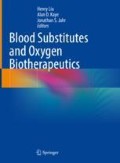Abstract
Artificial oxygen ca obtain a stable mixture. Perfluorocarbons rriers are classified into two broad categories: hemoglobin-based and perfluorocarbon-based. Both provide oxygen transport to tissues. For several decades, perfluorocarbons have been explored as oxygen carriers in a variety of biological applications. Perfluorocarbons are chemically and physiologically inert, have excellent temperature and storage stability, represent little to no infectious danger, are commercially available, and have well-established gas transport qualities. Perfluorocarbons are compounds that have high solubility for many gases, but they are not suitable for direct injection into the vascular system and require emulsification to obtain a stable mixture. Perfluorocarbons may be classified into five categories based on the primary perfluorocarbon backbone utilized in the product: (1) perfluorodecalin, (2) perfluorooctyll bromide, (3) tertbutylperfluorocyclohexane, (4) dodecafluoropentane, and (5) perftoran. When combined with other blood-saving strategies, the use of perfluorocarbon-based oxygen carriers enables the performance of surgical procedures with increased blood loss while eliminating or lowering the need for allogeneic transfusion. Other applications have been described and are under investigation.
Access this chapter
Tax calculation will be finalised at checkout
Purchases are for personal use only
References
Delaney M, Wendel S, Bercovitz RS, Cid J, Cohn C, Dunbar NM, et al. Transfusion reactions: prevention, diagnosis, and treatment. Lancet. 2016;388(10061):2825–36.
Goodnough LT. Risks of blood transfusion. Crit Care Med. 2003;31(12 Suppl):S678–86.
Henkel-Hanke T, Oleck M. Artificial oxygen carriers: a current review. AANA J. 2007;75(3):205–11.
Riess JG. Understanding the fundamentals of perfluorocarbons and perfluorocarbon emulsions relevant to in vivo oxygen delivery. Artif Cells Blood Substit Immobil Biotechnol. 2005;33(1):47–63.
Spahn DR. Blood substitutes. Artificial oxygen carriers: perfluorocarbon emulsions. Crit Care. 1999;3(5):R93–7.
Dalvi VH, Rossky PJ. Molecular origins of fluorocarbon hydrophobicity. Proc Natl Acad Sci U S A. 2010;107(31):13603–7.
Jagers J, Wrobeln A, Ferenz KB. Perfluorocarbon-based oxygen carriers: from physics to physiology. Pflugers Arch. 2021;473(2):139–50.
Haldar R, Gupta D, Chitranshi S, Singh MK, Sachan S. Artificial blood: a futuristic dimension of modern day transfusion sciences. Cardiovasc Hematol Agents Med Chem. 2019;17(1):11–6.
Schutt EG, Klein DH, Mattrey RM, Riess JG. Injectable microbubbles as contrast agents for diagnostic ultrasound imaging: the key role of perfluorochemicals. Angew Chem Int Ed Engl. 2003;42(28):3218–35.
Lemal DM. Perspective on fluorocarbon chemistry. J Org Chem. 2004;69(1):1–11.
Riess JG. Perfluorocarbon-based oxygen delivery. Artif Cells Blood Substit Immobil Biotechnol. 2006;34(6):567–80.
Kirsch P. Modern fluoroorganic chemistry: synthesis, reactivity, applications. 2nd ed. John Wiley & Sons, Inc; 2013.
Yokoyama K. Effect of perfluorochemical (PFC) emulsion on acute carbon monoxide poisoning in rats. Jpn J Surg. 1978;8(4):342–52.
Wrobeln A, Laudien J, Gross-Heitfeld C, Linders J, Mayer C, Wilde B, et al. Albumin-derived perfluorocarbon-based artificial oxygen carriers: a physico-chemical characterization and first in vivo evaluation of biocompatibility. Eur J Pharm Biopharm. 2017;115:52–64.
Mayer D, Ferenz KB. Perfluorocarbons for the treatment of decompression illness: how to bridge the gap between theory and practice. Eur J Appl Physiol. 2019;119(11–12):2421–33.
Khan F, Singh K, Friedman MT. Artificial blood: the history and current perspectives of blood substitutes. Discoveries (Craiova). 2020;8(1):e104.
Ferenz KB, Steinbicker AU. Artificial oxygen carriers-past, present, and future-a review of the most innovative and clinically relevant concepts. J Pharmacol Exp Ther. 2019;369(2):300–10.
Spiess BD. Perfluorocarbon gas transport: an overview of medical history with yet unrealized potentials. Shock. 2019;52(1S Suppl 1):7–12.
Eggleton CD, Roy TK, Popel AS. Predictions of capillary oxygen transport in the presence of fluorocarbon additives. Am J Physiol. 1998;275(6):H2250–7.
Wrobeln A, Schluter KD, Linders J, Zahres M, Mayer C, Kirsch M, et al. Functionality of albumin-derived perfluorocarbon-based artificial oxygen carriers in the Langendorff-heart (dagger). Artif Cells Nanomed Biotechnol. 2017;45(4):723–30.
Bachert SE, Dogra P, Boral LI. Alternatives to transfusion. Am J Clin Pathol. 2020;153(3):287–93.
Williamson LM, Devine DV. Challenges in the management of the blood supply. Lancet. 2013;381(9880):1866–75.
Castro CI, Briceno JC. Perfluorocarbon-based oxygen carriers: review of products and trials. Artif Organs. 2010;34(8):622–34.
Latson GW. Perftoran (Vidaphor)-Introduction to Western medicine. Shock. 2019;52(1S Suppl 1):65–9.
Jahr JS, Guinn NR, Lowery DR, Shore-Lesserson L, Shander A. Blood substitutes and oxygen therapeutics: a review. Anesth Analg. 2021;132(1):119–29.
Wrobeln A, Jagers J, Quinting T, Schreiber T, Kirsch M, Fandrey J, et al. Albumin-derived perfluorocarbon-based artificial oxygen carriers can avoid hypoxic tissue damage in massive hemodilution. Sci Rep. 2020;10(1):11950.
Hirschl RB, Conrad S, Kaiser R, Zwischenberger JB, Bartlett RH, Booth F, et al. Partial liquid ventilation in adult patients with ARDS: a multicenter phase I-II trial. Ann Surg. 1998;228(5):692–700.
Author information
Authors and Affiliations
Corresponding author
Editor information
Editors and Affiliations
Rights and permissions
Copyright information
© 2022 The Author(s), under exclusive license to Springer Nature Switzerland AG
About this chapter
Cite this chapter
Kaye, A.D., Samaniego, K., Miriyala, S., Miller, B.C., Cornett, E.M., Conrad, S.A. (2022). Perfluorocarbon-Based Oxygen Carriers. In: Liu, H., Kaye, A.D., Jahr, J.S. (eds) Blood Substitutes and Oxygen Biotherapeutics. Springer, Cham. https://doi.org/10.1007/978-3-030-95975-3_16
Download citation
DOI: https://doi.org/10.1007/978-3-030-95975-3_16
Published:
Publisher Name: Springer, Cham
Print ISBN: 978-3-030-95974-6
Online ISBN: 978-3-030-95975-3
eBook Packages: MedicineMedicine (R0)

